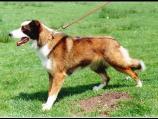
This is a placeholder text
Group text
by Mcap on 03 April 2012 - 14:04
Thanks
Mike
by Von Ward Kennels on 03 April 2012 - 19:04
Why don't you feed real raw food that has not been prepared?
by EuroShepherd on 04 April 2012 - 23:04
One reason why it is lower in protein (wether you measure it by weight or volume) is because it has a much higher water weight.
You need to be very careful about feeding high protein dry kibble to large breed puppies. A diet too high in protein has been linked to structural problems. (also, never feed pups synthetic or non-bone/egg sourced calcium, this can also cause structural and joint problems.)
A dog's digestive system is designed to utilize raw food the best. It will only take the calcium and minerals it needs from raw bones/egg shells and discard the rest. It is capable of fully absorbing and maximizing the nutritional value of proteins from raw flesh.
When food is cooked and synthetic proteins or other nutritients are added the chemical make-up of the food is dramatically different. It can be more difficult for the dog's body to absorb what it needs and it can make the absorbtion of nutrients very imbalanced. Absorbing less actual usable protein from cooked or synthetically prepared foods and absorbing more calcium and minerals than it needs from the synthetic nutrients. Basically the body becomes confused. This is why dogs poop so much more when fed cooked foods.
You would actually be better off not feeding the kibble you are feeding, even if it is a better kibble than other brands, and only feeding your pups the raw food diet.
When it comes to feeding dogs vegetables, it's best that the veggies are blanched or steamed first, in the wild, carnivores source most of their veggies from the stomach and guts of their prey. Those gut contents have already been broken down some by the herbivores so that the carnivores can digest the nutrients from the vegetation.
The ingredients of the Bravo balanced meals look pretty good to me, your pups will be able to utilize it's lower protein content much better than the higher protein content of the dry kibble.
(personally I wouldn't feed my dogs brocolli since it can cause gas, and I would put more herbs-especially parsley, in their diet.)
by tony74 on 12 April 2012 - 07:04
not sure what type of raw diet you are feeding but if you will feed a raw rabbit diet or add rabbit in what ever you are feeding rabbit is naturally high in protien and vitiman(B) we feed alot of raw rabbit to our pets they have a much better coat and color and they are never sick the vet said what ever we are doing to keep it up lol i told him what we are feeding he said great we need to be that rabbit was very good for them due to the high % protien and vitiman in rabbit hope this helps you my friend
by uvw on 12 April 2012 - 20:04
also, for vitamin b, as per the usda nutrient data base, lean beef has almost 3 times b12 as rabbit.
in general, when feeding raw, you shouldn't be focusing in on certain values individually. you need to provide as wide a variety as you can.
by Jenni78 on 12 April 2012 - 23:04
Also, excellent point about the danger of synthetic vitamins, which most kibbles have.
Raw is higher protein, but usually around 2/3 water, hence the difference in percentages "as fed."
Here is an excerpt: http://dogcathomeprepareddiet.com/dietrelated_skeletal_and_joint.html
Calcium Supplements Promote Orthopedic Problems
Is there any harm in oversupplementing a growing puppy with a vitamin-mineral mixture? Long-term high calcium intake in large breed puppies can increase blood calcium and phosphate, retard bone maturation, retard bone remodeling, retard cartilage maturation, and disturb growth plates. Their manifestations include osteochrondrosis, bowed legs, and stunted growth. Young dogs have no mechanism to protect against excess dietary calcium. Excess calcium deposits primarily in bone, and with little reabsorption of bone calcium, severe abnormalities develop in the young growing skeleton. The normal remodeling process cannot compensate for these changes.
Calcium is the major factor for skeletal disease developing in growing giant-breed dogs. The dietary level of calcium is the cause. Once, rather than the level of calcium, many believed that an imbalance in the ratio of calcium to phosphorous was the cause. Most nutritional recommendations over the years emphasized the need for a proper ratio of the two minerals or skeletal disease would develop. Most blamed orthopedic problems on an improper ratio. Imbalances in the ratio of calcium to phosphorus occur most commonly when dogs and cats eat an all-meat diet. These diets often contain no bone. They are very high in phosphorus and low in calcium. The calcium to phosphorus ratio for an all-meat diet is likely to be 1:10 to 1:50. The proper ratio should be 1.3:1, or close to one. Feeding a high phosphorus and low calcium diet causes calcium removal from bones to maintain normal blood calcium. Bone calcium loss results in soft bones that fracture easily.
The puppy of a giant breed is more likely than other breeds to show skeletal abnormalities when consuming excess calcium. This doesn't mean that excess calcium is harmless to smaller dogs. Excess calcium should not be fed to any breed of animal. Pregnant animals often receive excess calcium. No pregnant animal, whatever its size or breed, should receive excess calcium, however. Feeding high levels of calcium can produce osteochrondosis in the fetus. Supplementation of calcium (but not to give an excess) is necessary to prevent osteopenia during pregnancy and lactation. The amount given can increase if necessary during lactation.
by magdalenasins on 13 April 2012 - 16:04
Contact information Disclaimer Privacy Statement Copyright Information Terms of Service Cookie policy ↑ Back to top




